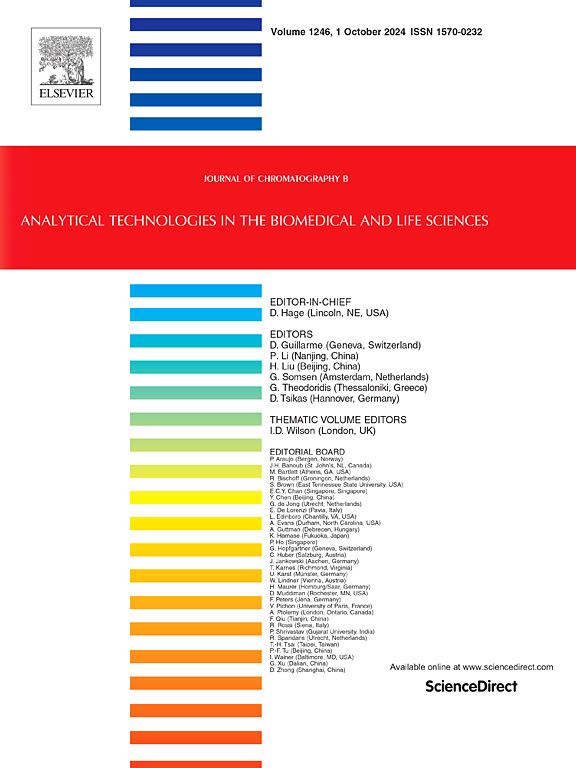Analysis of lipid nanoparticles using two-dimensional chromatography: Simultaneous determination of encapsulation efficiency, nucleic acid integrity, and size of LNP formulations
IF 2.8
3区 医学
Q2 BIOCHEMICAL RESEARCH METHODS
引用次数: 0
Abstract
Lipid nanoparticles (LNPs) have emerged as the most advanced drug delivery system for gene therapies and vaccines due to their ability to encapsulate a diverse range of payloads, including nucleic acids and proteins. LNPs provide many benefits, such as protection of payloads from enzymatic degradation, enhanced cellular uptake, and controlled release, making them promising candidates for therapeutic applications. The complex composition and inherent instabilities of LNPs present significant challenges for their characterization, especially in determining encapsulation efficiency, payload integrity, and size distribution. This study presents a two-dimensional chromatography (2D) method to simultaneously assess crucial parameters of LNP formulations. The method employs a switching chromatography system comprising two distinct analytical columns, independent pumps, and two detectors, including an ultraviolet-visible detector (UV–Vis) and a multi-angle light scattering detector (MALS). A key benefit of this advanced configuration is the direct analysis of LNPs without the need for sample preparation. The 2D technique enables accurate quantification of both encapsulated and non-encapsulated nucleic acids, evaluation of payload integrity, and determination of LNP size and size distribution. The results demonstrate that this method provides a comprehensive and robust analytical solution, enabling further development and understanding of lipid-based drug delivery systems. The validation of the technique confirms its sensitivity (LOD 15 ng mRNA, LOQ 45 ng mRNA), linearity (R2 > 0.99), precision (RSD < 15 %), accuracy (< 15 %), and potential to streamline and optimize process development, in-process control, and quality control of LNP formulations.
利用二维色谱法分析脂质纳米颗粒:同时测定LNP制剂的包封效率、核酸完整性和大小
脂质纳米颗粒(LNPs)已成为基因治疗和疫苗中最先进的药物输送系统,因为它们能够封装各种有效载荷,包括核酸和蛋白质。LNPs具有许多优点,例如保护有效载荷免受酶降解,增强细胞摄取和控制释放,使其成为治疗应用的有希望的候选者。LNPs的复杂组成和固有的不稳定性给其表征带来了重大挑战,特别是在确定封装效率、有效载荷完整性和尺寸分布方面。本研究提出了一种二维色谱(2D)方法来同时评估LNP配方的关键参数。该方法采用切换色谱系统,包括两个不同的分析柱、独立的泵和两个检测器,包括一个紫外-可见检测器(UV-Vis)和一个多角度光散射检测器(MALS)。这种先进配置的一个关键优点是直接分析LNPs而不需要样品制备。2D技术能够准确定量包封和未包封的核酸,评估有效载荷完整性,确定LNP大小和大小分布。结果表明,该方法提供了一个全面和稳健的分析解决方案,使进一步开发和了解基于脂质的药物传递系统。该技术的灵敏度(LOD 15 ng mRNA, LOQ 45 ng mRNA),线性度(R2 >;0.99),精密度(RSD <;15%),准确度(<;15%),并有潜力简化和优化工艺开发、过程控制和LNP配方的质量控制。
本文章由计算机程序翻译,如有差异,请以英文原文为准。
求助全文
约1分钟内获得全文
求助全文
来源期刊

Journal of Chromatography B
医学-分析化学
CiteScore
5.60
自引率
3.30%
发文量
306
审稿时长
44 days
期刊介绍:
The Journal of Chromatography B publishes papers on developments in separation science relevant to biology and biomedical research including both fundamental advances and applications. Analytical techniques which may be considered include the various facets of chromatography, electrophoresis and related methods, affinity and immunoaffinity-based methodologies, hyphenated and other multi-dimensional techniques, and microanalytical approaches. The journal also considers articles reporting developments in sample preparation, detection techniques including mass spectrometry, and data handling and analysis.
Developments related to preparative separations for the isolation and purification of components of biological systems may be published, including chromatographic and electrophoretic methods, affinity separations, field flow fractionation and other preparative approaches.
Applications to the analysis of biological systems and samples will be considered when the analytical science contains a significant element of novelty, e.g. a new approach to the separation of a compound, novel combination of analytical techniques, or significantly improved analytical performance.
 求助内容:
求助内容: 应助结果提醒方式:
应助结果提醒方式:


